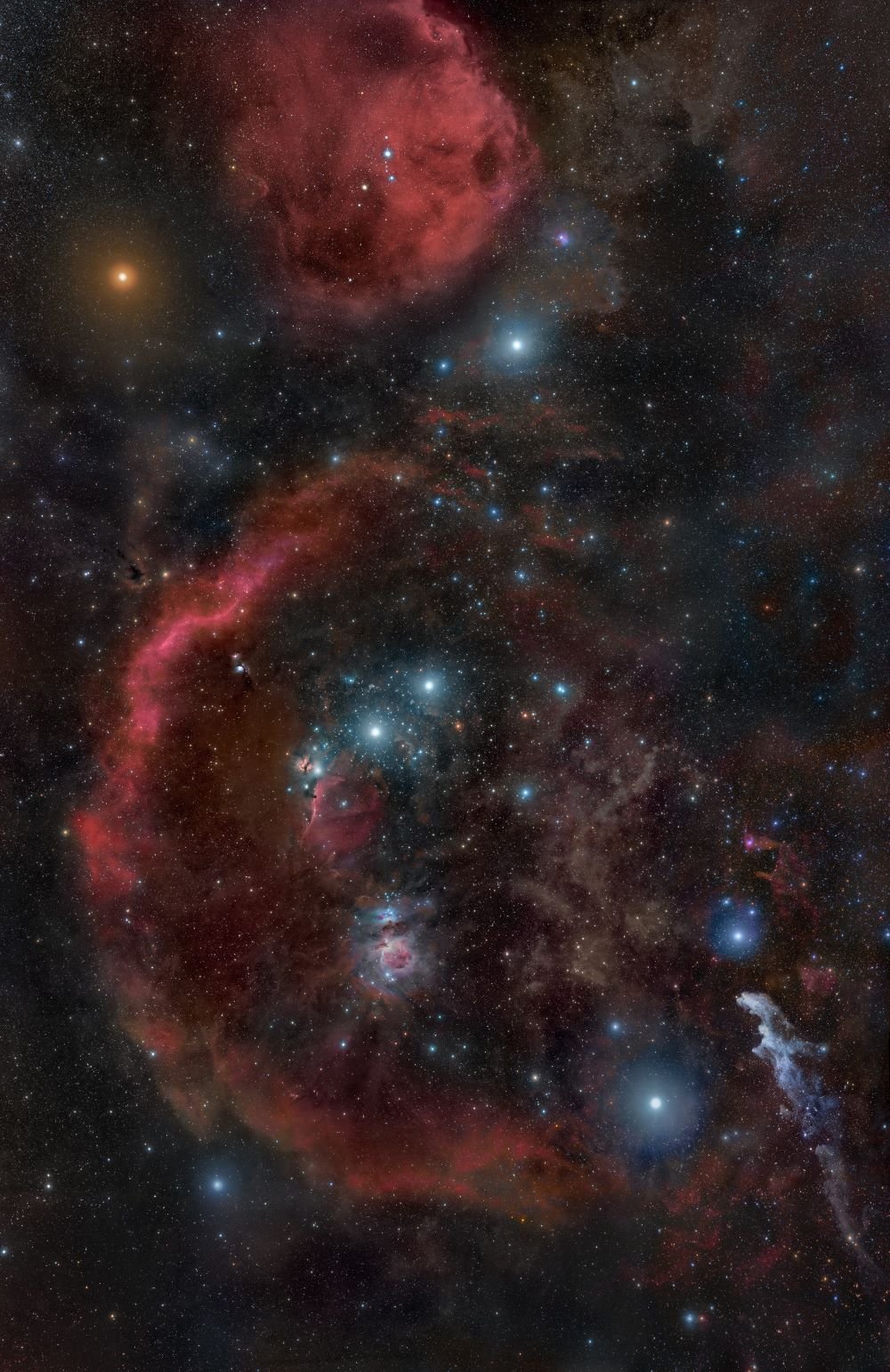January Nature Almanac: Orion
By Dave Sutherland
January 2025
"You know Orion always comes up sideways.
Throwing a leg up over our fence of mountains…”
From The Star-splitter by Robert Frost
This January, after the sun sets and the gloom gathers, cast your eyes to the southeast to watch the mighty stars of Orion rise majestically over the horizon. One of the most easily recognized constellations, The Hunter is also a treasure house of marvels — far more than I could fit into a dozen Nature Almanacs!
In Orion, stars are born from vast streams of floating gas; and here they die in cataclysmic explosions that light up the night sky.
The brightest stars of Orion are massive supergiants many times larger and hotter than the sun and — despite distances of around 1000 light years or more — they are still some of the most luminous stars in our sky.
A head-to-toe image of the stars in the Orion constellation with the nebulas of the Orion Molecular Cloud complex, the red supergiant Betelgeuse (top left) and the famous belt of Orion composed of the blue-white supergiants Alnitak, Alnilam and Mintaka. To the bottom right is Rigel, the Giant’s Foot. The famous Orion Nebula shines in the lower center below the stars of the belt, part of Orion’s Dagger. Photo by Rogelio Bernal Andreo, October 2010, CC BY-SA.
The relatively close Sirius the Dog Star, at only about 9 light years distant from us, is small and feeble in comparison and yet appears as our brightest start in the sky. If we could magically move Rigel, which is 860 light years away, one hundred times closer, and place it where Sirius is located: we would see it as a brilliant point of light blazing in the daytime sky, and at night it would cast our shadows on the ground.
In Greco-Roman mythology, Orion was a powerful hunter who threatened to kill every animal on earth. Enraged, Gaia the earth goddess sent a scorpion to kill him for his boast; and in the sky, Orion and Scorpius the scorpion are never visible at the same time.
But all the world’s cultures recognize these stars. Among Arab cultures, he was al-jabbar Jauzah the Giant One, and the names of the stars come to us from Arabic. The name Rigel derives from rijl al-jabbār, the giant’s foot; and the three brilliant stars of Orion’s Belt from left to right, Alnitak, Alnilam and Mintaka, are named for the giant’s girdle and a string of pearls. Betelgeuse, the bright red star in the upper left, may take its name as the hand of Jauzah the Giant.
Betelgeuse is one of the largest known stars. It has a radius between 640 and 764 times that of the Sun (it pulsates, changing in size and brightness), and if it were in place of the sun, its surface would lie outside the asteroid belt. At about 10 million years, it is a very young star, but is nearing the end of its life. Just a million years ago it was a blue-white blindingly hot super giant like Rigel, but huge stars burn through their fuel very quickly and have short but brilliant lives.
Now Betelgeuse is exhausting its fuel, swelling up into a red supergiant and cooling (it’s only red not, not blue hot like Rigel) and sometime in the next 100,000 years it will experience a catastrophic core collapse that will result in a titanic supernova explosion, literally blowing Betelgeuse to bits.
Fortunately, it is around 500 light years away, so the blast of radiation won’t have much effect on us; but it will light up the sky for a few months with a brilliance rivaling the full moon. Within a few million years, Rigel, Alnilam, Mintaka and the other blue-white supergiants of Orion will follow its lead and die in a blaze of glory.
Within the core of a supernova, unimaginable temperatures and pressures fuse light atoms into heavier elements like iron, silicon, cobalt and gold and the force of the explosion spreads these elements far across space in clouds of gas that can become new stars. Orion is a crucible of birth: the space between those bright stars is rich with the gaseous raw materials of new stars and planets.
Much of this gaseous raw material shines from the nearby light of the supergiants, lit up by radiation or reflection; but most of it is unlit, appearing as black silhouettes against brighter glowing clouds.
In the photo above, look for black knots, whorls and bands cutting across the light patches, such as the iconic horse head shape in the nebulous patch dangling from Alnitak, the leftmost star of the Belt. In the nearby Great Nebula of Orion, more of these gas clouds are lit up by a cluster newly formed stars. Four and a half billion years ago, the Sun and Earth formed in just such a cloud, with a host of newborn cluster mates that have now dispersed across the galaxy.
Take a pair of binoculars out on some clear January night and explore the marvels of Orion. The Great Nebula will appear as a hazy gray-green patch in the middle of Orion’s Dagger. Perhaps a new Sun with a new Earth-like planet is forming there right now.
Nature Almanac is a monthly series by Stephen R. Jones and R. Carol Cushman, along with other guest contributors. Ruth Carol Cushman and Stephen Jones are authors of A Field Guide to The North American Prairie (Peterson Field Guides) and Wild Boulder County: A Seasonal Guide to the Natural World.

